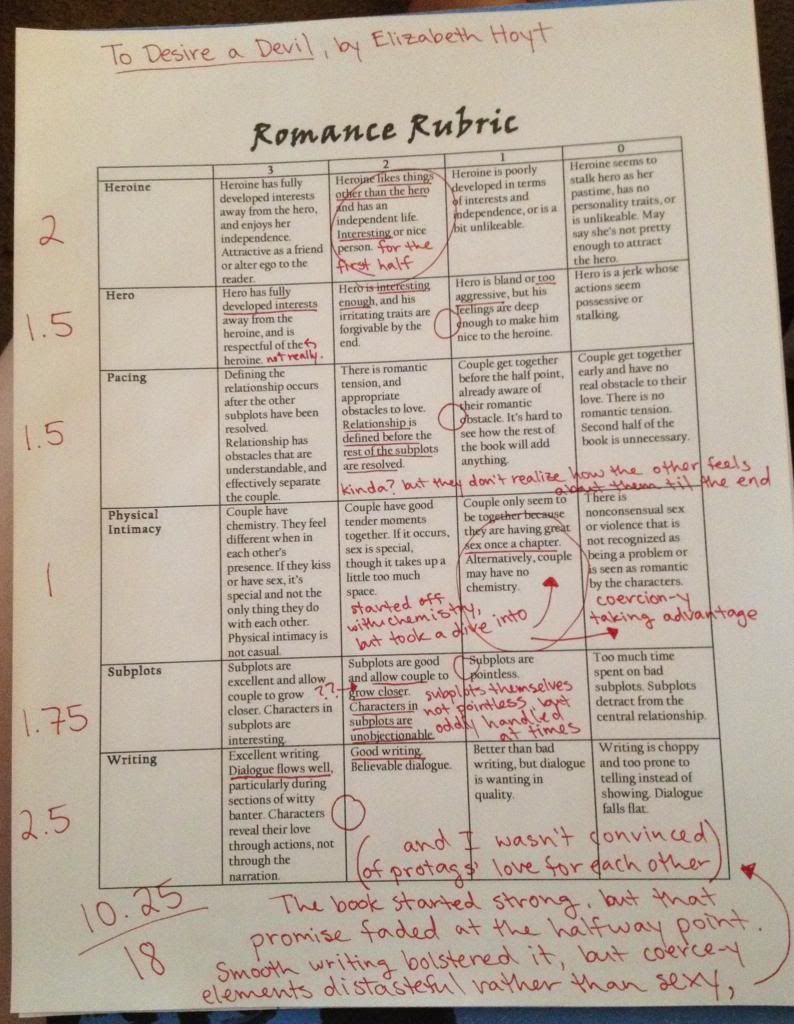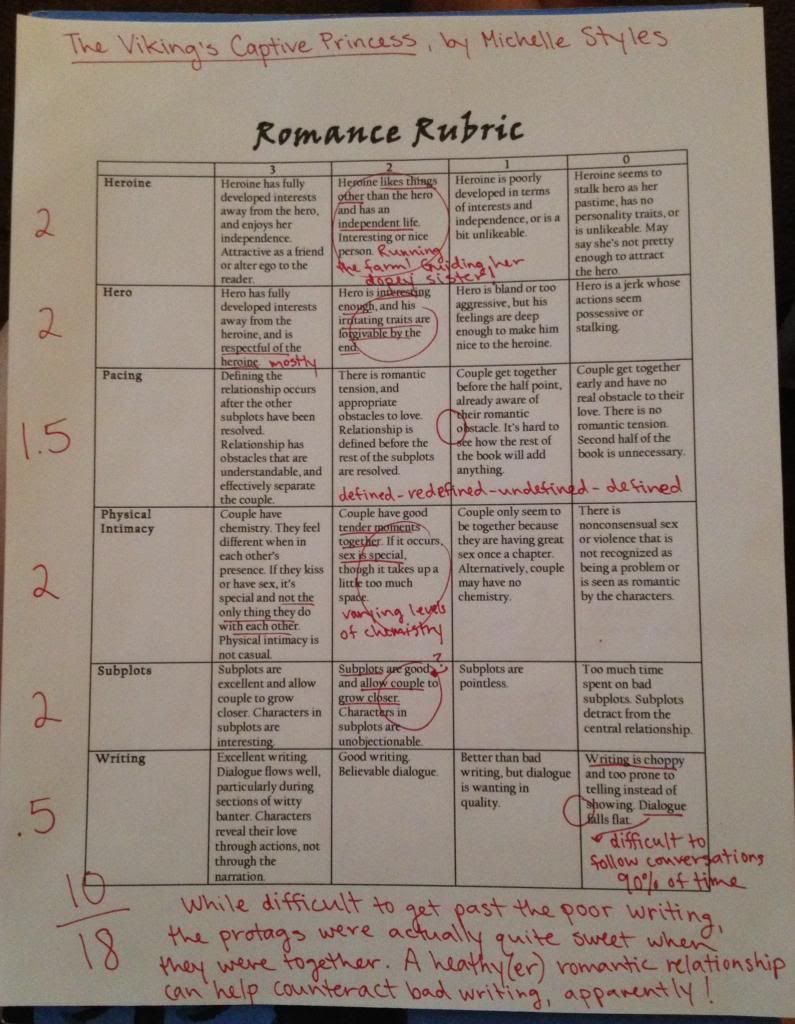Though it may turn out to be futile, I am dogged in my pursuit of a
2014 Reading Bingo blackout. The square I most recently had in my sights was “a book you could bring up at a bachelorette party,” which led me to some fantastic (read: not fantastic) romance novels found in the truly gargantuan collection of such at my local digital library. (It also occurs to me that my co-blogger and I are possibly the only weirdos in the world who think that book discussion at a bachelorette party is a thing that actually happens.) I found many that were enticing, but settled on these two for starters (and also because they had copies available for immediate download):

“Reynaud St. Aubyn has spent the last seven years in hellish captivity. Now half mad with fever he bursts into his ancestral home and demands his due. Can this wild-looking man truly be the last earl's heir, thought murdered by Indians years ago?
Beatrice Corning, the niece of the present earl, is a proper English miss. But she has a secret: No real man has ever excited her more than the handsome youth in the portrait in her uncle's home. Suddenly, that very man is here, in the flesh—and luring her into his bed.
Only Beatrice can see past Reynaud's savagery to the noble man inside. For his part, Reynaud is drawn to this lovely lady, even as he is suspicious of her loyalty to her uncle. But can Beatrice's love tame a man who will stop at nothing to regain his title—even if it means sacrificing her innocence?”
(Note: This book is the final volume in a quartet, but I was able to follow everything just fine without having read the previous three.)
So…let’s talk about this. Aside from some deplorable French in the early pages, it had a really promising start. Beatrice seemed like a heroine with a good head on her shoulders—level-headed, not afraid to stand up for herself, has a cool book-binding hobby, and affection for her family. Reynaud was also interesting—after years of captivity by Indians in the colonies, he has returned home ready to claim his place as Earl of Something-or-Other, while dealing with some understandable PTSD issues. He may be rough and quick to temper, but he is also loyal to his friends and takes up the mantle of responsibility for those he considers in his care.
The writing is smooth and engaging, pulling you along into the story, and I really enjoyed it for the first half of the book. Beatrice’s awkward position between her uncle the current earl and Reynaud the should-be earl created good tension—she feels Reynaud deserves the earldom, but is worried how her uncle will take having their current lifestyle revoked, and is torn between her loyalty to him and her attraction to Reynaud. Reynaud, for his part, is simultaneously trying to solve the mystery of who betrayed his military unit 7 years prior that resulted in his capture by Indians, and trying to prove he is sane enough to retake the earldom (he thinks marriage will help his cause, and that Beatrice would be a convenient match). The side characters and plots were also engaging, with Beatrice’s friend Lottie dealing with marital strife in what had originally been a love match, and her childhood friend Jeremy, crippled in war and in poor health.
Then things took a turn for the worse. Reynaud’s hardened, though still-mostly-respectful character morphed into a coerce-y, take-advantage-y blob, which I’m sure you can imagine did stellar things for the romance. Beatrice’s best friend from childhood has just died and she’s inconsolable with grief? I know JUST the thing to cheer her up—roughly divesting her of her virginity while she’s grief-stricken and in no state to be making important life decisions! That’s romantic, right? Or at least sexy? Jeez. I mean, I know most people don’t read bodice-rippers because they actually want to have their clothes literally torn off their bodies during their own intimate encounters, but there is a line between titillating and distasteful, and that scene was firmly in the latter category. Ugh.
It was mostly downhill after that. Everything that made Beatrice cool to begin with sort of faded away until she was mostly, “Oh! I love him, but he doesn’t love me!” without much of her original personality intact. Reynaud continued on his path of domineering selfishness and disrespect, largely dismissive of Beatrice’s concerns and opinions both in and out of the bedroom. I think there was only one sex scene that showed genuine, mutual tenderness.
The two get married well before the climax of the story, but don’t realize how the other person feels about them (in Beatrice’s case) or that what they’re feeling is indeed love (in Reynaud’s case) until the end of the book. I guess that was supposed to be the emotional payoff, but I didn’t really buy it. Everything else gets tied up, too—the earldom situation is handled to everyone’s benefit, the mystery of the betrayal in the colonies is solved, and the subplot involving Lottie and her husband is resolved without much actually happening. Even the writing, which was quite good to begin with, became less so as the book went on, with inconsistencies and convenient resolutions to many of the conflicts. All in all, I was disappointed that a story that had started off so strongly devolved into something less compelling with an often uncomfortable relationship at its heart.
Clearly, a romance rubric was in order.


“Dangerous warrior Ivar Gunnarson is a man of deeds, not words. With little time for the ideals of love, Ivar seizes what he wants--and Princess Thyre will not become the exception to his rule! Mysterious and enchanting, Thyre rouses Ivar's desire the moment he lays eyes on her. With Viking factions engaged in a bloody feud, Thyre is yet another captive this hardened warrior conquers--but to be king of Thyre's ‘heart’ will entail a battle he has never engaged in before…”
This book kind of ended up being the inverse of the previous one—largely bad writing, but the relationship at the heart of it was actually kind of sweet. The tender moments between Thyre and Ivar were really the only times I was able to get caught up in the reading—the rest of the time the writing was so flawed that I found it difficult to take the book seriously.
That plot blurb from GoodReads does a pretty crappy job of explaining the (admittedly somewhat convoluted) plot, so I’ll try to sum it up with a bit more detail. Thyre lives with her stepdad and half-sister in a viking kingdom called Ranriken. Her mother, Sainsfrida, is dead, but was actually a princess of Ranriken once upon a time. Back then, something happened and the king (Sainsfrida’s brother, I believe) sent her as a hostage to the ruler of a nearby viking kingdom called Viken. The princess eventually got knocked up while at the Viken court, and was rescued by her friend Ragnfast and taken back to Ranriken. The Viken ruler supposedly told her to kill the baby if it was a girl and send it back to him if it was a boy, and the princess’ brother/king was upset that she got knocked up by an enemy and exiled her to live in the boonies with Ragnfast and illegitimate baby Thyre, whom she did not kill. AND THAT’S JUST THE BACKGROUND INFORMATION.
So Thyre’s mom is dead, and she’s living with Ragnfast and her dopey half-sister. Thyre pretty much runs the steading, and then one day some Viken trader/warriors wash up on her shores after a storm. They’re supposed to show the sailors hospitality while they fix up their ship, and shenanigans ensue, with the result being that their leader, Ivar, claims Thyre as his concubine and takes her back to Viken with him. This part is not actually as creepy as it could be—after Ragnfast commands the sister to sleep with Ivar (which is apparently part of the whole hospitality thing), Thyre tricksily plots with her to switch places to a) protect her sis, who has sworn herself to another man, and b) have a say in who she herself sleeps with before she’s married off to the abusive neighbor. Ivar, for his part, realizes it’s not the sister, preferred Thyre anyway, and was set to just sleep. Like I said, convoluted, but it actually kinda made sense in the context of the story.
So Ivar and Thyre continue to alternately vex and beguile each other as they head back to Viken together with the rest of the crew. There’s a plot involving people from Ranriken trying to rob the Viken on the high seas, and another with Thyre deciding whether or not to reveal her true identity to both Ivar and her father, the ruler of Viken, and yet another with Thyre being antagonized by the Viken ruler’s current wife. Thyre and Ivar are forced to marry, though neither of them really minds, even if they haven’t confessed their true feelings to each other yet. Somehow the high seas attack has endangered Thyre’s family and the steading, and she sneaks on Ivar’s ship when he sails back to help them. All plots points swirl in convergence as Ivar and Thyre realize they love each other, save Ranriken from her uncle’s evil rule, and ease tensions between the two kingdoms!
Whew. This one clearly had a lot of other-plot going on in addition to the romance, which became problematic for me due to the shoddy writing. The writing issues were distracting to the point that I lost a lot of interest in even trying to follow the story and the conversations people were having (seriously, most of the time characters spoke to one another it felt like an exchange entirely of non-sequiturs). Dialogue that didn’t flow, research into the time period not smoothly incorporated, side characters who were flat or whose motivations were difficult to follow…there was a lot that made my inner editor’s fingers twitch toward the red pen.
And yet, I will give credit where it’s due—the majority of interactions and moments shared by Thyre and Ivar were sweet. Thyre is fiery and doesn’t take crap from anyone, and Ivar is alpha-male without being a dick about it. He is respectful of her and appreciates her for who she is, and Thyre feels/treats him in the same way. There were some moments when one or both of them would have a less-respectful thought about the other after some clash of their personalities or wills, but these seemed out-of-character from everything else we knew about them and I ignored them as writing wonk.
One thing that would hit me every so often while reading was how much I would rather be reading the story of Thyre’s mom, Ragnfast, and what went down at the Viken court all those years ago. Did Sainsfrida and the Viken king love each other? What about her friendship with Ragnfast, which was strong enough to compel him to rescue her alone? And then the two friends ended up married (forced by the Ranriken king, but married nonetheless) and exiled, so did they come to love each other eventually? This sounds like a much more absorbing story. I need answers!
Overall, I can’t really say I recommend it, but I felt surprisingly less twitchy about the writing problems than usual, thanks to the central relationship that managed to develop with tenderness and respect, as well a bit of fire and personality conflict. This one’s romance rubric, for comparison purposes:

(Apparently I was so irritated by rubricking these less-than-awesome books that I forgot how to spell “healthy.”)
So which book comes out on top in a battle between good writing/uncomfortable relationship and bad writing/better relationship? Per the incontrovertible rubric, it looks like in this case it’s too close to proclaim either a definitive winner. To Desire a Devil gets a nod for (mostly) smooth writing, while The Viking’s Captive Princess takes the cake (well, maybe just a bite of it) for a relationship that was (mostly) more pleasant to read about, but neither gets my full endorsement.
To Desire a Devil, by Elizabeth Hoyt
Published by Vision (2009)
Read in May 2014; from the library
The Viking’s Captive Princess, by Michelle Styles
Published by Harlequin Historical (2009)
Read in May 2014; from the library
 Title: Casebook
Title: Casebook





















